Items filtered by date: October 2024
The Effects of Fabry Disease on the Feet
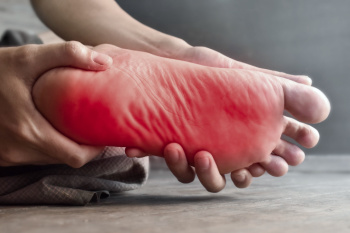
An unusual systemic condition that can affect the feet is Fabry disease, a rare genetic disorder that impacts the body's ability to break down a specific type of fat. This leads to the buildup of fat in various organs, including the skin, nervous system, and kidneys. In the feet, Fabry disease often causes painful burning sensations or tingling, particularly in the soles and toes, due to nerve damage, or peripheral neuropathy. These symptoms can be triggered or worsened by physical exertion, stress, or changes in temperature. Additionally, people with Fabry disease may experience decreased sweating, which can lead to dry, cracked skin on the feet, making them more prone to infections. Because Fabry disease affects multiple systems in the body, it requires careful management by specialists. If you suffer from Fabry disease or have these types of foot symptoms, it is strongly suggested that you consult a podiatrist for early intervention and control of foot problems to prevent long-term damage.
When dealing with systemic disease of the feet, it is extremely important to check the affected areas routinely so that any additional problems are caught quickly. If you have any concerns about your feet and ankles contact one of our podiatrists from Bruening Foot & Ankle. Our doctors will assist you with all of your podiatric needs.
Systemic Diseases of the Feet
Systemic diseases affect the whole body, and symptoms usually are displayed in the feet. This condition can make a patient’s ability to walk unbearable. Systemic diseases include gout, diabetes mellitus, neurological disorders, and arthritis.
Gout – is caused by an excess of uric acid in the body. Common symptoms include pain, inflammation, and redness at the metatarsal/phalangeal joint of the base big toe. Gout can be treated by NSAIDs to relieve pain and inflammation, and other drugs that lower the acid levels in the body.
Diabetes mellitus – is an increase in the level of blood sugar that the body cannot counteract with its own insulin. Failure to produce enough insulin is a factor in Diabetes.
Diabetes of the Feet
Diabetic Neuropathy – may lead to damaged nerves and affect the feet through numbness and loss of sensation.
Peripheral Vascular Disease – can restrict the blood flow to the feet, and often times lead to amputation of the feet.
If you have any questions please feel free to contact our offices located in Covina and Alta Loma, CA . We offer the newest diagnostic and treatment technologies for all your foot and ankle needs.
Treatment of Plantar Warts
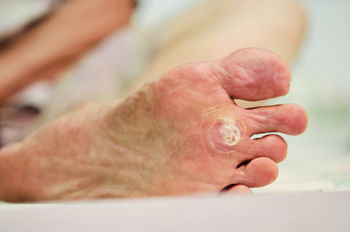
Plantar warts are growths that appear on the soles of the feet, caused by the human papillomavirus, or HPV. They occur when the virus enters the skin through tiny cuts or breaks, often from walking barefoot in moist environments like locker rooms or public pools. Children, teenagers, and people with weakened immune systems are more prone to developing plantar warts. These warts usually look like small, rough, grainy bumps with tiny black dots, which are clotted blood vessels. They can be painful, especially when walking or standing, as pressure pushes the wart inward, causing discomfort. Plantar warts are contagious and can spread. Treatment options include cryotherapy, or freezing the wart, or stronger treatments. If you have a plantar wart that is painful or spreading, it is suggested that you visit a podiatrist for proper removal and to prevent spreading the virus to other areas of the foot or body.
Plantar warts can be very uncomfortable. If you need your feet checked, contact one of our podiatrists from Bruening Foot & Ankle. Our doctors will assist you with all of your foot and ankle needs.
About Plantar Warts
Plantar warts are the result of HPV, or human papillomavirus, getting into open wounds on the feet. They are mostly found on the heels or balls of the feet.
While plantar warts are generally harmless, those experiencing excessive pain or those suffering from diabetes or a compromised immune system require immediate medical care. Plantar warts are easily diagnosed, usually through scraping off a bit of rough skin or by getting a biopsy.
Symptoms
- Lesions on the bottom of your feet, usually rough and grainy
- Hard or thick callused spots
- Wart seeds, which are small clotted blood vessels that look like little black spots
- Pain, discomfort, or tenderness of your feet when walking or standing
Treatment
- Freezing
- Electric tool removal
- Laser Treatment
- Topical Creams (prescription only)
- Over-the-counter medications
To help prevent developing plantar warts, avoid walking barefoot over abrasive surfaces that can cause cuts or wounds for HPV to get into. Avoiding direct contact with other warts, as well as not picking or rubbing existing warts, can help prevent the further spread of plantar warts. However, if you think you have developed plantar warts, speak to your podiatrist. He or she can diagnose the warts on your feet and recommend the appropriate treatment options.
If you have any questions please feel free to contact our offices located in Covina and Alta Loma, CA . We offer the newest diagnostic and treatment technologies for all your foot and ankle needs.
Custom Orthotics Provide Relief From Heel Pain

Experiencing persistent heel pain? Custom Orthotics might be your solution. These custom-designed shoe inserts adapt to your unique foot structure, optimizing support and alleviating discomfort. By redistributing pressure, they can significantly reduce heel pain, enhancing your daily mobility. Dive into a pain-free lifestyle and elevate your walking experience. Curious about the benefits of Custom Orthotics?
Contact our office today.
Hammertoe Deformities

Hammertoe deformities are one of the most common issues affecting the lesser toes, typically causing the joint in the middle of the toe to bend downward, resembling a hammer. This condition often results from an imbalance in the muscles, tendons, or ligaments that normally keep the toes straight. Causes include wearing tight or ill-fitting shoes, injuries, or underlying conditions such as arthritis or high arches. Symptoms include pain, stiffness, and difficulty straightening the affected toe. Over time, the deformity can cause friction against shoes, leading to painful corns, calluses, and inflammation. Pain occurs due to increased pressure on the bent joint and surrounding tissues. To relieve discomfort, one can switch to wider shoes with a soft, roomy toe box and use orthotic inserts. In severe cases, surgery may be needed to realign the joint and restore normal toe function. If you have a painful hammertoe, it is suggested that you visit a podiatrist for an exam and treatment.
Hammertoe
Hammertoes can be a painful condition to live with. For more information, contact one of our podiatrists from Bruening Foot & Ankle. Our doctors will answer any of your foot- and ankle-related questions.
Hammertoe is a foot deformity that affects the joints of the second, third, fourth, or fifth toes of your feet. It is a painful foot condition in which these toes curl and arch up, which can often lead to pain when wearing footwear.
Symptoms
- Pain in the affected toes
- Development of corns or calluses due to friction
- Inflammation
- Redness
- Contracture of the toes
Causes
Genetics – People who are genetically predisposed to hammertoe are often more susceptible
Arthritis – Because arthritis affects the joints in your toes, further deformities stemming from arthritis can occur
Trauma – Direct trauma to the toes could potentially lead to hammertoe
Ill-fitting shoes – Undue pressure on the front of the toes from ill-fitting shoes can potentially lead to the development of hammertoe
Treatment
Orthotics – Custom made inserts can be used to help relieve pressure placed on the toes and therefore relieve some of the pain associated with it
Medications – Oral medications such as anti-inflammatories or NSAIDs could be used to treat the pain and inflammation hammertoes causes. Injections of corticosteroids are also sometimes used
Surgery – In more severe cases where the hammertoes have become more rigid, foot surgery is a potential option
If you have any questions please contact our offices located in Covina and Alta Loma, CA . We offer the newest diagnostic and treatment technologies for all your foot and ankle needs.
What Type of Orthotic Is Best for You?
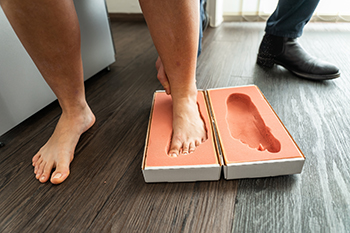
Custom-made orthotics are specialized devices designed to address a variety of foot conditions. Two common types are functional and rigid orthotics, each serving distinct purposes. Functional orthotics are typically softer and provide support while allowing for some movement. They are effective for conditions such as plantar fasciitis and overpronation, helping to correct alignment and improve foot function during activity. Rigid orthotics, on the other hand, are made from firmer materials and offer more substantial support. They are ideal for managing conditions like flat feet and severe arthritis, as they help stabilize the foot and redistribute weight. By choosing the appropriate type of custom orthotic, individuals can significantly improve comfort, reduce pain, and enhance overall mobility. If you have a foot condition that is causing pain and discomfort, it is suggested that you consult a podiatrist who can determine whether custom-made orthotics can provide the relief you are seeking.
If you are experiencing discomfort in your feet and would like to try custom orthotics, contact one of our podiatrists from Bruening Foot & Ankle. Our doctors can provide the care you need to keep you pain-free and on your feet.
What Are Custom Orthotics?
Custom orthotics are inserts you can place into your shoes to help with a variety of foot problems such as flat feet or foot pain. Orthotics provide relief and comfort for minor foot and heel pain.
Over-the-Counter Inserts
Shoe inserts come in a wide variety and are used to treat foot pain, heel pain, and minor problems. For example, arch supports can be inserted into your shoes to help correct overarched or flat feet, while gel insoles are often used because they provide comfort and relief from foot and heel pain by alleviating pressure.
Prescription Orthotics
If over-the-counter inserts don’t work for you or if you have a more severe foot concern, it is possible to have your podiatrist prescribe custom orthotics. These high-quality, custom inserts are designed to treat problems such as abnormal motion, plantar fasciitis, and severe forms of heel pain. They can even be used to help patients suffering from diabetes by treating foot ulcers and painful calluses and are usually molded to your feet individually, which allows them to provide full support and comfort.
If you're experiencing minor to severe foot or heel pain, it’s recommended to speak with your podiatrist about the possibility of using custom orthotics or shoe inserts. A podiatrist can determine which type of custom orthotic or shoe insert is right for you and help you take the first steps toward being pain-free.
If you have any questions please contact our offices located in Covina and Alta Loma, CA . We offer the newest diagnostic and treatment technologies for all your foot and ankle needs.
Plantar Warts Can Be Treated!
Female Footwear and Effects on the Feet
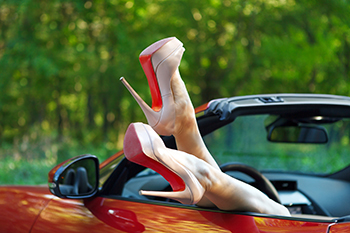
Traditionally female footwear, such as high heels, pointed-toe shoes, and narrow-fitting flats, can have harmful effects on the feet. High heels shift body weight onto the front of the foot, leading to pressure on the toes and the ball of the foot, which can cause conditions like bunions, hammertoes, and metatarsalgia. Pointed-toe shoes squeeze the toes, causing misalignment and painful deformities. Flats without proper arch support can lead to conditions like plantar fasciitis or tendonitis. Over time, these shoes can also contribute to poor posture, back pain, and joint issues due to improper weight distribution. To promote foot health, choose footwear with a wide toe box, cushioning, and arch support. Low-heeled or flat shoes with proper support can prevent pain and foot damage. If foot pain persists or worsens, it is suggested that you visit a podiatrist who can assess the issue and recommend suitable treatments or custom orthotics.
High heels have a history of causing foot and ankle problems. If you have any concerns about your feet or ankles, contact one of our podiatrists from Bruening Foot & Ankle. Our doctors can provide the care you need to keep you pain-free and on your feet.
Effects of High Heels on the Feet
High heels are popular shoes among women because of their many styles and societal appeal. Despite this, high heels can still cause many health problems if worn too frequently.
Which Parts of My Body Will Be Affected by High Heels?
- Ankle Joints
- Achilles Tendon – May shorten and stiffen with prolonged wear
- Balls of the Feet
- Knees – Heels cause the knees to bend constantly, creating stress on them
- Back – They decrease the spine’s ability to absorb shock, which may lead to back pain. The vertebrae of the lower back may compress.
What Kinds of Foot Problems Can Develop from Wearing High Heels?
- Corns
- Calluses
- Hammertoe
- Bunions
- Morton’s Neuroma
- Plantar Fasciitis
How Can I Still Wear High Heels and Maintain Foot Health?
If you want to wear high heeled shoes, make sure that you are not wearing them every day, as this will help prevent long term physical problems. Try wearing thicker heels as opposed to stilettos to distribute weight more evenly across the feet. Always make sure you are wearing the proper shoes for the right occasion, such as sneakers for exercising. If you walk to work, try carrying your heels with you and changing into them once you arrive at work. Adding inserts to your heels can help cushion your feet and absorb shock. Full foot inserts or metatarsal pads are available.
If you have any questions please feel free to contact our offices located in Covina and Alta Loma, CA . We offer the newest diagnostic and treatment technologies for all your foot and ankle needs.
Causes of Tarsal Tunnel Syndrome
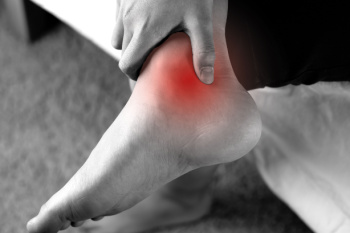
Tarsal tunnel syndrome is a condition resulting from compression of the posterior tibial nerve as it passes through the tarsal tunnel, located on the inside of the ankle. This compression can result in such symptoms as numbness, tingling, and burning pain in the foot and toes. The condition is often caused by repetitive stress, injury, or inflammation that narrows the tarsal tunnel and places pressure on the nerve. Other contributing causes include flat feet, cysts, or varicose veins. Symptoms of tarsal tunnel syndrome typically worsen with activity and may improve with rest. If you have pain in this area of your foot, it may indicate tarsal tunnel syndrome. It is suggested that you consult a podiatrist who can accurately diagnose and treat this condition.
Tarsal tunnel syndrome can be very uncomfortable to live with. If you are experiencing tarsal tunnel syndrome, contact one of our podiatrists of Bruening Foot & Ankle. Our doctors can provide the care you need to keep you pain-free and on your feet.
Tarsal Tunnel Syndrome
Tarsal tunnel syndrome, which can also be called tibial nerve dysfunction, is an uncommon condition of misfiring peripheral nerves in the foot. The tibial nerve is the peripheral nerve in the leg responsible for sensation and movement of the foot and calf muscles. In tarsal tunnel syndrome, the tibial nerve is damaged, causing problems with movement and feeling in the foot of the affected leg.
Common Cause of Tarsal Tunnel Syndrome
- Involves pressure or an injury, direct pressure on the tibial nerve for an extended period of time, sometimes caused by other body structures close by or near the knee.
- Diseases that damage nerves, including diabetes, may cause tarsal tunnel syndrome.
- At times, tarsal tunnel syndrome can appear without an obvious cause in some cases.
The Effects of Tarsal Tunnel Syndrome
- Different sensations, an afflicted person may experience pain, tingling, burning or other unusual sensations in the foot of the affected leg.
- The foot muscles, toes and ankle become weaker, and curling your toes or flexing your foot can become difficult.
- If condition worsens, infections and ulcers may develop on the foot that is experiencing the syndrome.
A physical exam of the leg can help identify the presence of tarsal tunnel syndrome. Medical tests, such as a nerve biopsy, are also used to diagnose the condition. Patients may receive physical therapy and prescriptive medication. In extreme cases, some may require surgery.
If you have any questions please feel free to contact our offices located in Covina and Alta Loma, CA . We offer the newest diagnostic and treatment technologies for all your foot and ankle needs.

